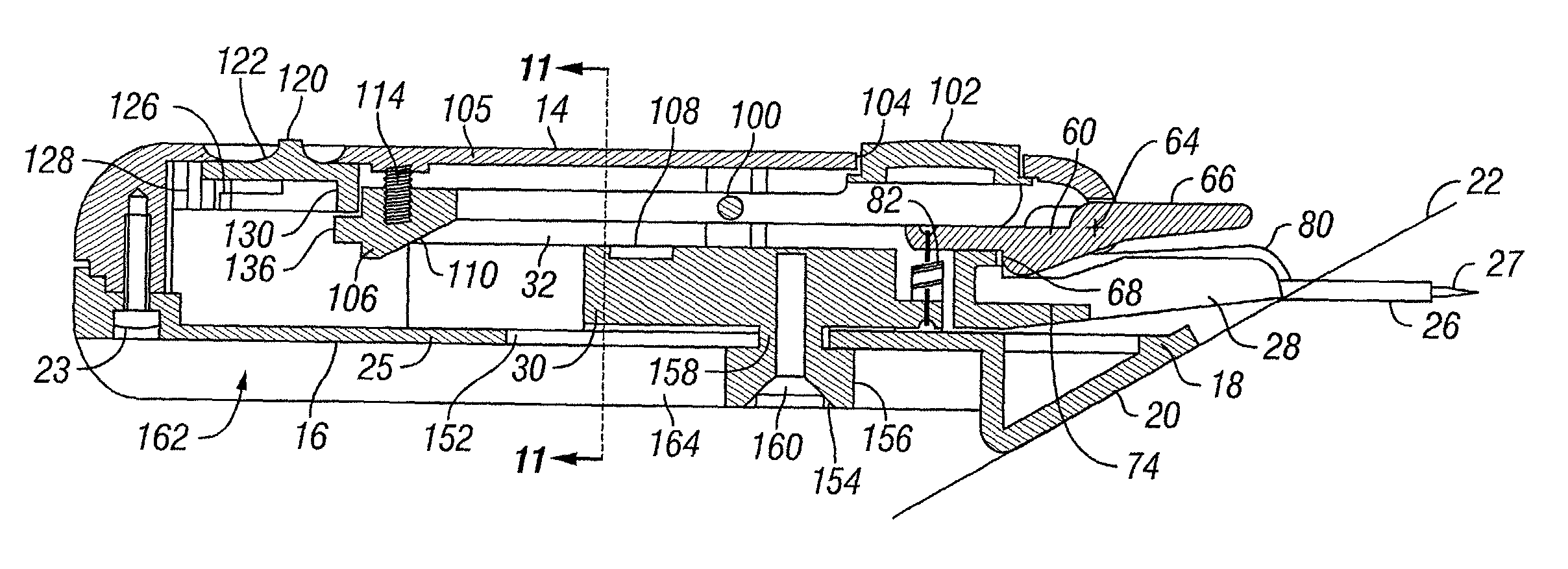Transcutaneous inserter for low-profile infusion sets
a low-profile, inserter technology, applied in the field of medical devices, can solve the problems of affecting the flow of insulin, requiring manual dexterity, and kinking of the cannula,
- Summary
- Abstract
- Description
- Claims
- Application Information
AI Technical Summary
Benefits of technology
Problems solved by technology
Method used
Image
Examples
second embodiment
[0036]With reference now to FIGS. 7 and 8, a low-profile inserter assembly 140 according to the invention is illustrated, wherein like parts in the previous embodiment are represented by like numerals. The inserter assembly 140 is similar in construction to the inserter assembly 10, with the exception that an upper housing portion 142 and lower housing portion 144 are narrowed in width behind the release button 102 to form a narrowed handle portion 146 that is easier to hold and manipulate. This narrower width necessitates moving the tension springs 92 (not shown in FIG. 7) inward, closer to the longitudinal centerline of the housing. These springs will now be located under the retainer 30 rather than on each side as shown in FIGS. 4 and 5. However they are attached to the retainer side flange 42 and guide flange 32 of the upper housing portion 142 in a similar manner.
third embodiment
[0037]With reference now to FIGS. 9–11, a low-profile inserter assembly 150 according to the invention is illustrated, wherein like parts in the previous embodiments are represented by like numerals. In this embodiment, a slot 152 is formed in the bottom wall 25 of the lower housing portion 16. A single cocking lever 154 extends downwardly through the slot 152 from the retainer 30. As shown, the cocking lever 154 includes a head portion 156 that is larger than the slot and a neck portion 158 that extends through the slot. The neck portion 158 is preferably integrally formed with the retainer 30. A fastener 160 is countersunk in the head portion 156 and extends through the head and neck portions 156, 158 and into the retainer 30 for securing the head portion to the retainer.
[0038]The bottom wall 25 is formed in a depression 162 of the lower housing portion 16 and is defined by a pair of inner side walls 164 (only one shown in FIG. 9) that extend downwardly from the bottom wall 25. An...
fourth embodiment
[0040]With reference now to FIGS. 12–14, a low-profile inserter assembly 170 according to the invention is illustrated, wherein like parts in the previous embodiments are represented by like numerals. The inserter assembly 170 includes a housing 172 that is relatively wide in comparison to the previous embodiments. The housing 172 has an upper housing portion 174 connected to a lower housing portion 176 in a manner as previously described. A bifurcated base 178 is preferably integrally formed with the lower housing portion 176 and includes spaced feet 180, 182. Each foot has a lower surface 184 that extends at an acute angle θ with respect to a lower surface 186 of the lower housing portion 176 so that an insertion needle 17 and cannula 26 of a low-profile cannula housing 28 placed in the inserter assembly 170 can be inserted into the skin 24 at the proper angle, as previously described. In one preferred embodiment, the angle θ is approximately 30° to accommodate a cannula that will...
PUM
 Login to View More
Login to View More Abstract
Description
Claims
Application Information
 Login to View More
Login to View More - R&D
- Intellectual Property
- Life Sciences
- Materials
- Tech Scout
- Unparalleled Data Quality
- Higher Quality Content
- 60% Fewer Hallucinations
Browse by: Latest US Patents, China's latest patents, Technical Efficacy Thesaurus, Application Domain, Technology Topic, Popular Technical Reports.
© 2025 PatSnap. All rights reserved.Legal|Privacy policy|Modern Slavery Act Transparency Statement|Sitemap|About US| Contact US: help@patsnap.com



